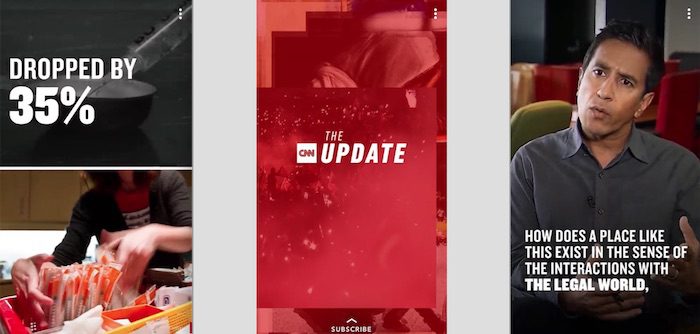
Maintaining a 24-hour news TV channel is one thing. Developing a daily show on Snapchat Discover is another.
Three months after making the transition from the Discover platform’s text-based newsmagazine format to a daily video show, CNN’s Snapchat style is clearly different from other publishers on the app known for captivating teenagers’ attention with instantaneous sharing, breakdancing hot dogs, and voice changing filters. You won’t see single-second shots or snappily colored graphics cartwheeling over a single anchor in The Update, CNN’s brand ambassador to the youth, but rather a “cast of characters” steadily sharing the news in a slower-paced manner that doesn’t break too far from CNN’s flagship cable news channel.
“Snapchat is a part of, for us, a larger social and digital strategy which is about creating the CNN news habit for every generation on every platform,” said Samantha Barry, CNN’s executive producer for social and emerging media. “We’re telling great stories on the platforms where they live. They’re getting to know those three red and white letters for what it stands for: great news and information.”
CNN was one of Snapchat’s earliest media partners, with ties from an investment from Time Warner (CNN’s parent company) and its hiring of former CNN reporter Peter Hamby as the platform’s head of news in May 2015. When the Discover section, prominently featuring news from legacy organizations, launched in January 2015, CNN was one of 10 media partners alongside ESPN and National Geographic. But the content was largely text-based, and Snap controlled (and still does) who could actually publish within Discover.That administrative upper hand has helped the platform avoid the pitfalls of user-generated authoritative-seeming content, such as fake news. Bloomberg’s Max Chafkin points out that “whereas Facebook deliberately blurs the line between personal status updates, news articles, and ads — sticking all three in its constantly updating, algorithm-driven News Feed — Snapchat has taken a more old-fashioned approach. The app’s news section, Discover, is limited to professionally edited content, including dozens of channels maintained by old-media outlets.”
CNN’s Snapchat show fits more with the old-media style of sharing information. CNN joined NBC News as a hard news provider on the platform, the latter launching its twice-daily show a month before. (NBCUniversal invested $500 million into Snap in March.) Discover offers plenty of entertainment content in addition to Snapchat’s curated and user-focused Our Stories, but NBC News’s Stay Tuned, CNN’s The Update, and Hamby’s Good Luck America weekly docu-series are shows that delve into current events, breaking news, politics, and analysis. Even then, it’s typically Snapchat-style politics and analysis — NBC News’ Nick Ascheim emphasized the importance of being high-energy: “Each show has to engage from literally the first second. It’s so easy to tap through a segment of the show…You have to provide them a very clear reason from the get-go why they should be sitting through this.”Barry said she’s fine with The Update moving more slowly than other Snapchat shows. “Snapchat is about taking fantastic journalism and serving it up in a way that is palatable for the platform,” she said. “In my opinion, it doesn’t need to be full of bells and whistles and flashes in order to engage somebody. Content engages. Great journalism engages users.”
The Update has featured dispatches from North Korea, special reports on gun ownership after the mass shooting in Las Vegas, and sexual harassment allegations after the Harvey Weinstein news broke. Unlike the NBC News show’s two alternating hosts and team devoted specifically just for the show’s production, The Update features that rotating cast of characters” as Barry put it, of its anchors and correspondents for different stories with the CNN logo prominent rather than a pair of hosts. But that’s also an edge for their show over the previous magazine Discover format: “We didn’t in Discover have the opportunity to highlight all the anchors and reporters,” Barry said. Its relationship to the CNN TV programming is more seamless: The Update is released every day at 6 p.m. and encompasses content covered on the network, though not necessarily recycling the same footage.
“As a video-led network, we distribute our content on so many platforms. One of the challenges is if you are talking about legacy TV and 16×9 in digital that is shot a certain way,” Barry said. “It’s not always repurposed square for Facebook or vertical for Snapchat. Where do we make those decisions to create original content?”
Barry said the show comes from a team of “six dedicated producers that work on an edition of The Update on any given day” in New York, Atlanta, and London.